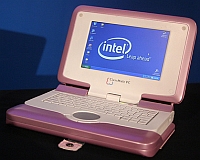Back in October we reported that there would be a OLPC Children's Machine XO vs. Intel Classmate PC battle in Brazil. Now that Intel has upped the ante and donated 700+ Classmates, other experts are starting to compare the two laptop's feature set.
But don't be mislead by megabytes or operating systems. If you just look at the technology, the OLPC is far superior; it is truly a revolution in laptop design, not Intel's small evolution. Better yet, don't even focus on the technology at all. Take Nicholas Negroponte's advice - think about the two systems as education projects, not laptop projects.
Then you'll really note the starkly different implementation approaches between Intel and One Laptop Per Child.
At the most basic level, Intel is designing the Classmate PC to be an educational tool controlled by the teacher. Intel says it the best in its Intel World Ahead, Brazil press kit:

The Classmate PC platform is a teacher-student computing solution designed to serve the educational needs in developing countries.The platform brings a complete hardware and localized pedagogical software solution that enables classroom and content management. This is being achieved through interaction with local pedagogical content providers and educators.
Classmate PC is made of three key elements, a small form factor, affordable and rugged notebook designed for students, a teacher console unit, and a complete integrated software management solution.
One Laptop Per Child has a whole different outlook, based on Semyor Papert's "Constructionist" philosophy. According to the shockingly thin 1,200 word, Learning Vision on the OLPC Wiki, laptops will enable children to "learn learning" and liberate students to "actively engage with others with similar interests in cultures of learning" without much in the way of detail or real-world justification.
The Learning Vision also suggest that teachers, freed from the need to teach, will then "focus their experience and expertise where most needed," with those needs and roles undefined. That OLPC implementation plan can be visualized with this simple graphic:
And so I'll say it again, when it's Classmate PC vs. OLPC XO, Intel's Classmate PC technology is only a cheaper laptop. It is not the paradigm shifting technology of the OLPC XO Children's Machine. However, Intel's World Ahead implementation methodology is just that - a world ahead of the One Laptop Per Child's drop it off at the country's door delivery plan.



This reminds one of Negroponte's quip that since rich countries spend so much on students already, they would not need OLPC equipment.
But OTOH, if OLPC is about teaching philosophy rather than hardware, then wouldn't the same philosophy trumpeted to solve third-world problems also apply here? In other words, if Papert's ideas are not in implementation vogue here, then why not push OLPC here too? (Or is someone claiming that "constructionist" learning is a well-estabilished principle here?)
or what i keep asking myself: if constructionist learning is such an amazing advance in education, why isn't it used widely already?
it sounds like another ivory tower solution in search of a problem.
Teacher (and anonymous, too);
You pose an interesting thought - is the OLPC an attempt to push an educational theory as much as it is to push a new technology? What are the moral and cultural questions raised by that - just because our friends in Boston think that constructivism is the way to go, is that objectively true (or even measurable?) universally applicable in the myriad of cultural and institutional education traditions of the countries that the OLPC laptop will be sold to? Shouldn't they have more of a choice in the matter (beyond the choice of not buying any of the OLPC laptops, because let's face it, they're pretty great).
Only a teacher - and I am one - could ask why a demonstrably better technique isn't widely implemented. In most schools teaching is about control more than learning. One of the best features of computer technology is that it won't fit that model. Once the kids learn to use even a bit of the computer they're teaching themselves and each other.